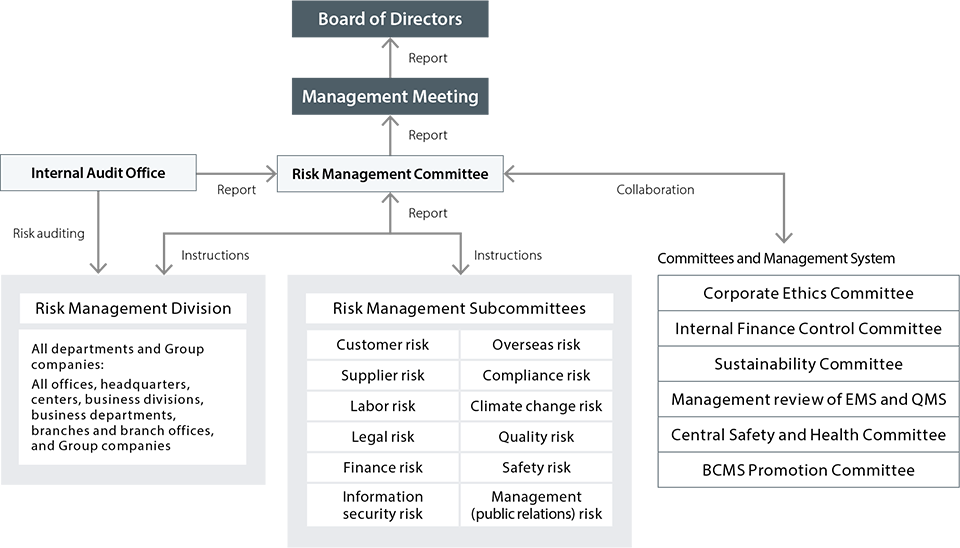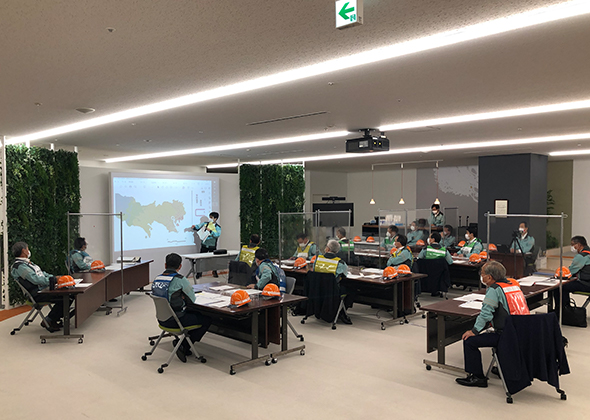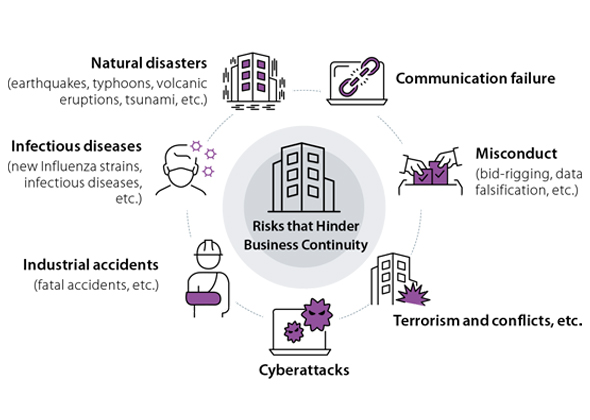Risk Management
Basic Philosophy
The Sanki Engineering Group's daily risk management is undertaken by the Risk Management Committee based on the Risk Management Rules. We have also established an Enterprise Risk Management system that includes operation of the Business Continuity Management System, which safeguards the effectiveness of business continuity planning in the event of contingencies.
Risk Management Promotion System
We set up the Risk Management Committee, chaired by a risk management officer, to centrally manage Group-wide risks and implement an organized response. The committee monitors important risks throughout the Group, formulates a control plan, and monitors risks reported by subcommittees and divisions. To enhance the effectiveness of our risk assessment and control, we have set up the Risk Management Subcommittee to address specific risks under the Risk Management Committee.
Framework of the Risk Management System (as of June 21, 2024)

Risk Management Activities
Each fiscal year, the Risk Management Committee identifies risks that affect business activities and stipulates priority risk items for the next fiscal year. The committee receives reports from the risk management subcommittees to monitor risks and consider necessary countermeasures, provides instructions, and confirms the status of progress.
- ● Business Operation Risks
- - Common to all construction businesses
- ・Securing human resources
- ・Increase in materials and labor osts and delays in delivery of materials and equipment
- ・Overseas business risks
- ・Accidents and disasters during construction
- ・Unprofitable construction
- ・Risks related to litigation, etc.
- - Facilities Construction Business
- ・Overabundance of planned projects and increase in property size
- ・Response to global challenges
- - Machinery Systems Business
- ・Decrease in capital investment
- ・Decline in competitiveness
- - Environmental Systems Business
- ・Changes in market conditions
- ・Long-term business risks
- - Real Estate Business
- ・Rent fluctuations
- ・Decline in occupancy rate
- - Common to all construction businesses
- ● Financial and Other Risks
- Customer credit risk
- Stock market fluctuations
- Interest rate fluctuations
- Seasonal fluctuations in business performance
- Legal violations
- Overwork
- Human rights violations
- War, terrorism, and natural disasters
- Climate change
- Infectious disease epidemic
- Data security breach
- System failure
- Intensifying digital competition
Business Continuity Management System (BCMS)
To prepare against risks that could hinder business continuity, we have formulated and put into place a business continuity plan (BCP) to ensure the safety of all related persons, including employees, through the integrated efforts of all executives and employees. In fiscal 2021, we began preparing to establish a BCMS as a mechanism for the effective maintenance and management of the BCP, and began operating the system in fiscal 2022.
Under the BCMS, we laid out an annual plan to periodically review the BCP through PDCA activities (business impact analysis, education, training, internal audits, management review, review, and improvement) and by coordinating with risk management undertaken by the Risk Management Committee. During the review process, we conduct a business impact analysis, from the perspectives of risk assessment and impact evaluation, to investigate and analyze the degree to which each target operation will be impacted in the event a risk materializes and to take concrete measures to strengthen corporate resilience.
Furthermore, to realize a system for rapid business recovery and maintenance, we formulated risk-specific response guidelines based on the BCP Common Version, which describes our basic response policy. The guidelines address the seven risks of natural disasters, infectious diseases, industrial accidents, cyberattacks, terrorism, misconduct, and communication failure. Since fiscal 2023, the scope of the BCMS has been expanded to include domestic Group companies. In addition, to prepare forcontingencies, we continue to provide BCMS training for directors and employees, conduct periodic drills, and add to our emergency supplies. In particular, we began conducting new drills for industrial accidents, cyberattacks, and misconduct, in addition to drills for natural disasters, to strengthen our response capabilities.


